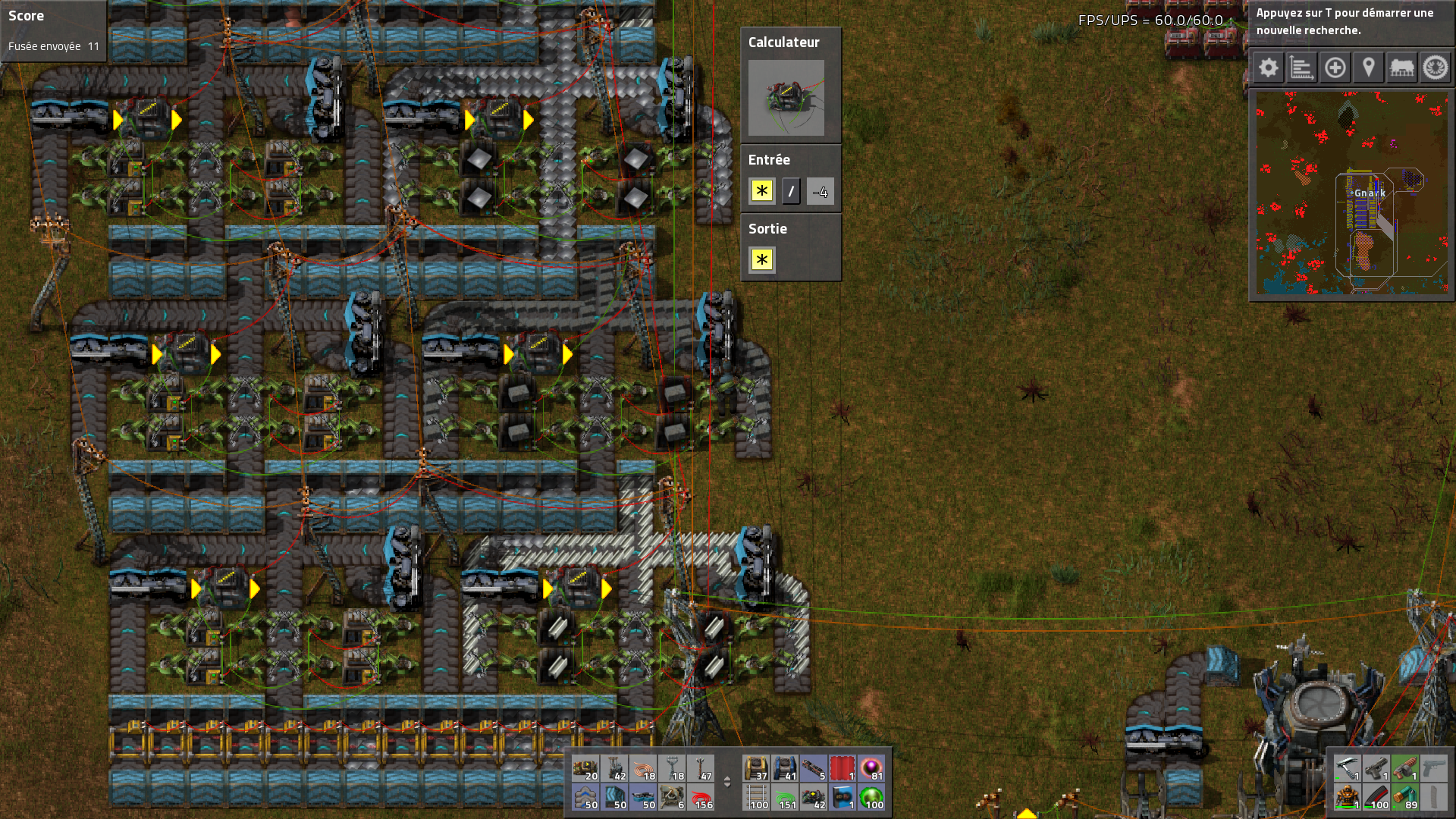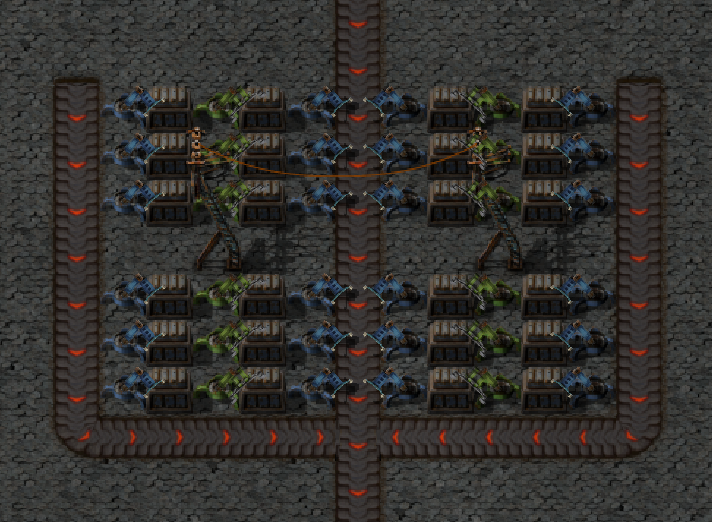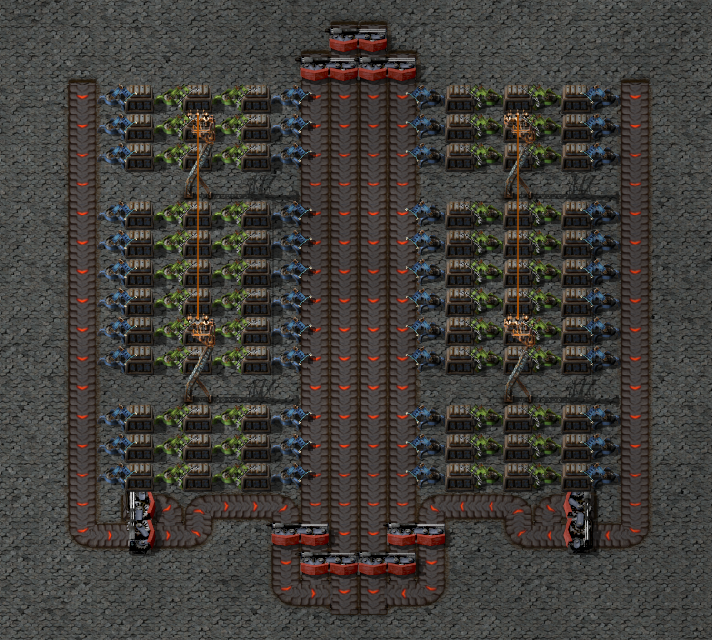Page 2 of 2
Re: Belt buffers
Posted: Mon Dec 08, 2014 3:09 pm
by Zourin
A lot of resource hoggy options. A solution should be simple and effective.
This isn't a 'simple' demonstration of a load-balanced output buffer, but it gets the job done. I am also really tight on space for a place where this would be functional, even if for a demonstration.
It can be expanded to around 3-4 inserter-chest sets, or more if you really need that much storage capacity. This is enough to signal a shortage before there actually is one. Ideally, i'd suggest 3-4 chests in a line to help keep the smelters running during early low demand periods.
The simple shift-balancer works because the output is one-side only. A storage site, as opposed to a simple buffer, would be a bit more comprehensive, but I don't intend for the entire base to run off this one inserter.

This is an ultra-light buffer ideal for buffering research packs. Pretty much what I tried to describe earlier, but I had to put a bend in it due to space restrictions. I will make ANYTHING work.. somehow.

Re: Belt buffers
Posted: Sun Dec 11, 2016 1:50 pm
by Grimakar
I am doing a lot of experimenting with buffers.
First I took this one, which worked quiet well:
But with more loads that quickly became too small. So I experimented with two belt buffers and stayed with the next buffer, that can handle quiet a load but still is not perfect. There still happen some micro gaps on the output line.
I also searched the internet and this forum, but I could not find larger collections. Do you have a link? Or maybe you know better compact designs.
I'll go on experimenting with buffers and post them.
Re: Belt buffers
Posted: Sun Dec 11, 2016 2:28 pm
by impetus maximus
Nova wrote:I don't know why buffers should be important for anything beside trains. If there's a shortage in your production, where's the problem? Only fuel for boilers and things for ammunition could be a problem, but anything else could just not produce as much and be uninteresting.
i feel the same way. the only buffers i use are for trains. to each their own i guess.

Re: Belt buffers
Posted: Sun Dec 11, 2016 2:52 pm
by Hannu
User_Name wrote:
If your buffer is not leaking, at the 2 hour mark you will notice that you are running out of ore (buffer will start to saturate main bus)
You will have ~1 and a half hour to fix it. Your factory will run at full speed.
Without buffer, you probably won't notice iron shortage until 3 - 3.5 hour mark, when lack of compression will become visible to the naked eye.
You will have less than hour to fix it. Your factory will starve on iron.
You are right. But I can open new iron mine at about 30 minutes. I just lay rails and build miners and stuff with robots and add new mine in the schedule of one of the ore trains. I have usually many iron mines in different stages of depletion. If my base starves slightly 30 minutes it have absolutely no meaningful effect to anything. Number of launched rockets increases little slower than normally. Such and much worse situations are common due to construction works or other disturbances.
As you probably noticed I do not use belt buffers. Chest row in stations is enough, for example 8x6 chests can have 230 k metal plates. I have one exception. If I do not use accumulators to store energy I have coal storage with large power plants. I use usually modded warehouse in such situation.
Re: Belt buffers
Posted: Sun Dec 11, 2016 3:39 pm
by Grimakar
impetus maximus wrote:i feel the same way. the only buffers i use are for trains. to each their own i guess.

Well, you are trolling the thread. This is about showing buffer creations. Maybe you should start a new thread to discuss the pro and cons or the need and no-need of buffers.
Re: Belt buffers
Posted: Sun Dec 11, 2016 6:04 pm
by Mehve
You people realize that this is a thread from 2014, right?
Re: Belt buffers
Posted: Sun Dec 11, 2016 7:34 pm
by Grimakar
Mehve wrote:You people realize that this is a thread from 2014, right?
And there is the next troll...
Yes, I realized it. I wanted to write something about buffers and there was the choice between making a new thread or first search the forum, if there is an existing thread, because that's how it goes.
Is that ok for you?
Re: Belt buffers
Posted: Sun Dec 11, 2016 7:49 pm
by Hannu
Grimakar wrote:Yes, I realized it. I wanted to write something about buffers and there was the choice between making a new thread or first search the forum, if there is an existing thread, because that's how it goes.
Is that ok for you?
It is OK for me, but many forums prefer new threads even there are old thread in same topic. I think that most English speaking forums prefer new thread if old one is couple of weeks old but many Finnish forums prefer searching of old thread and continuing it. It is interesting difference in cultures.
In my opinion, if I ask how to do something, I appreciate also answers how to achieve same results by avoiding whole thing. If I want to do something by some way I usually write that I want to do it and not use other possible more optimal ways. In my opinion first writer did not specify anything about that. Probably he has found answers years ago (I did not notice that this is old thread) and I do not disturb discussions about technical details of buffers any more.
Re: Belt buffers
Posted: Sun Dec 11, 2016 7:53 pm
by Arch666Angel
Re: Belt buffers
Posted: Sun Dec 11, 2016 7:56 pm
by impetus maximus
Mehve wrote:You people realize that this is a thread from 2014, right?
and?
Re: Belt buffers
Posted: Sun Dec 11, 2016 9:15 pm
by mergele
ssilk wrote: This is of course not always possible, but I mean it is a bit important to talk about this in a multiplayer game, cause if some play for resource
surplus and other play for
production surplus you come into some small or big problems.

You run into having a whole lot of
production. "Guys, our green circuit
production can support a rocket per minute, think we should move on to science 3?
Re: Belt buffers
Posted: Sun Dec 11, 2016 11:11 pm
by Mehve
Hannu wrote:It is OK for me, but many forums prefer new threads even there are old thread in same topic. I think that most English speaking forums prefer new thread if old one is couple of weeks old but many Finnish forums prefer searching of old thread and continuing it. It is interesting difference in cultures.
That's fair, I suppose. The reason I commented was because we have posts quoting people from years ago - a little tricky to carry on any meaningful discussion that way

Not to mention that there's been changes in inserter design and belt behaviour since then, so what worked then won't necessarily work now. We also have things like stack inserters and the ability to directly scan belt contents, which makes buffering a lot simpler.
Re: Belt buffers
Posted: Sun Dec 11, 2016 11:41 pm
by aober93
Why so complicated lol. Simply have an incoming belt put into a chest, and on the opposite side out of the chest, onto a belt. Put a few chests in parallel for more thruput and capacity. Thats it.
Re: Belt buffers
Posted: Mon Dec 12, 2016 12:29 am
by ssilk
The linked wiki-article is completely out of date. I would use for example combinator logic to start and stop belts.
For example a "real" belt buffer would store items on belts instead in chests. You can store more than 100 items per 14 tiles of belt.
The right mix between fast belt buffer and "slow" chest buffer.
Re: Belt buffers
Posted: Mon Dec 12, 2016 12:59 am
by Mehve
aober93 wrote:Why so complicated lol. Simply have an incoming belt put into a chest, and on the opposite side out of the chest, onto a belt. Put a few chests in parallel for more thruput and capacity. Thats it.
Yeah, on the rare chance I feel the need to buffer large quantities, that's pretty much my go-to method. Simple, space-efficient, and can be extended as long as you need.

Re: Belt buffers
Posted: Mon Dec 12, 2016 2:09 pm
by OdinYggd
These days I usually use a 'high bypass' buffer system.

In this configuration, the bulk of the material bypasses the buffer in order to reduce power consumption and make it non-blocking in a low power situation.
I have the circuits configured such that the buffer will not fill unless the output is sufficiently compressed. Like so it will let the downstream fill up, then fill itself.
Since it can be easily lengthened as well, it is quite scaleable and can easily keep up with blue belt inputs and outputs.
Usually I use this sort of system on surge loaded materials such as coal, ores, and plates, sometimes circuits. Other things it is simply overkill, put an inline box on and call it done.
But buffering comes into play because your JIT mainline wants to run at a fixed speed while the load is variable. Having buffering on the raw input and final output of each assembly bank, you enter a situation where the excess capacity is stored for dealing with surge loads.
Re: Belt buffers
Posted: Tue Dec 13, 2016 1:01 pm
by Engimage
OdinYggd wrote:These days I usually use a 'high bypass' buffer system.

In this configuration, the bulk of the material bypasses the buffer in order to reduce power consumption and make it non-blocking in a low power situation.
I have the circuits configured such that the buffer will not fill unless the output is sufficiently compressed. Like so it will let the downstream fill up, then fill itself.
Since it can be easily lengthened as well, it is quite scaleable and can easily keep up with blue belt inputs and outputs.
Usually I use this sort of system on surge loaded materials such as coal, ores, and plates, sometimes circuits. Other things it is simply overkill, put an inline box on and call it done.
But buffering comes into play because your JIT mainline wants to run at a fixed speed while the load is variable. Having buffering on the raw input and final output of each assembly bank, you enter a situation where the excess capacity is stored for dealing with surge loads.
This is a brilliant design that will work even without any circuit magic. I would replace inner inserters with fast inserters though to decrease useless work when buffer is not filled up. Making buffer output offload to main belt sides make it work optimally in the case of backing up the belt. When buffer is full and belt is full this effectively stops buffer from taking any actions. It will automaticly unload if there is a gap in output belt by simply offloading from output belts to the main bus and you don't need any circuit logic for that. Replacing inner inserters with fast inserters (instead of stack inserters) will optimize energy use in the case of filling up the buffer while resource is still consumed but slower than belt can move.
BTW this design can output with a speed of a blue belt.
Re: Belt buffers
Posted: Sun Dec 18, 2016 1:50 pm
by Gnark
That is what I am building to buffer my main line in next fact :

It almost serve a compressed blue belt (need a small amount a input), it balance the lines and the design can be duplicated easily / parallelized.








